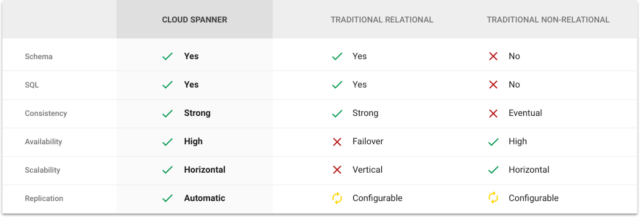Google Cloud Platform_Part 2
More Cloud Spanner customers share feedback
Quizlet, an online learning tool that supports more than 20 million students and teachers each month, uses MySQL as its primary database; database performance and stability are critical to the business. But with users growing at roughly 50% a year, Quizlet has been forced to scale its database many times to handle this load. By splitting tables into their own databases (vertical sharding), and moving query load to replicas, it’s been able to increase query capacity — but this technique is reaching its limits quickly, as the tables themselves are outgrowing what a single MySQL shard can support. In its search for a more scalable architecture, Quizlet discovered Cloud Spanner, which will allow it to easily scale its relational database and simplify its application:
“Based on our experience and performance testing, Cloud Spanner is the most compelling option we’ve seen to power a high-scale relational query workload. It has the performance and scalability of a NoSQL database, but can execute SQL so it’s a viable alternative to sharded MySQL. It’s an impressive technology and could dramatically simplify how we manage our databases.” — Peter Bakkum, Platform Lead, Quizlet
The history of Spanner
For decades, developers have relied on traditional databases with a relational data model and SQL semantics to build applications that meet business needs. Meanwhile, NoSQL solutions emerged that were great for scale and fast, efficient data-processing, but they didn’t meet the need for strong consistency. Faced with these two sub-optimal choices that customers grapple with today, in 2007, a team of systems researchers and engineers at Google set out to develop a globally-distributed database that could bridge this gap. In 2012, we published the Spanner research paper that described many of these innovations. The result was a database that offers the best of both worlds:
Remarkably, Cloud Spanner achieves this combination of features without violating the CAP Theorem. To understand how, read this post by the author of the CAP Theorem and Google Vice President of Infrastructure, Eric Brewer.
Over the years, we’ve battle-tested Spanner internally with hundreds of different applications and petabytes of data across data centers around the world. At Google, Spanner supports tens of millions of queries per second and runs some of our most critical services, including AdWords and Google Play.
If you have a MySQL or PostgreSQL system that’s bursting at the seams, or are struggling with hand-rolled transactions on top of an eventually-consistent database, Cloud Spanner could be the solution you’re looking for. Visit the Cloud Spanner page to learn more and get started building applications on our next-generation database service.
Right now, Cloud Spanner instances can only exist in one of Google’s cloud regions, though they’ll be replicated across multiple availability zones inside those regions.
In the future, Cloud Spanner customers will be able to have one database that’s kept in sync across multiple regions.


